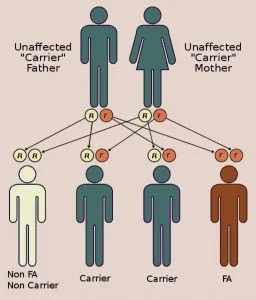Friedreich Ataxia
FA is a degenerative, genetic, neurological disease that appears predominantly in children and teenagers, usually first diagnosed between the ages of 5 and 15. FA causes difficulty walking, talking and performing everyday functions, soon leaving sufferers wheelchair-bound.
FA is a progressive condition and in time causes weakening of the limbs and eventually complete incapacitation. It does not affect intellectual capacity. It’s associated with vision, hearing and speech failure, combined with severe heart disease, scoliosis and diabetes and greatly reduced life expectancy.
FA is extremely rare, currently believed to affect about 1 in 50,000 people in Australia and New Zealand.
Cause
FA is caused by a defect in the genetic code by which the body functions (DNA). This defect results in reduction or lack of production of an important protein known as frataxin. Frataxin is an important protein in mitochondria, an energy powerhouse within cells and low frataxin levels are thought to result in poor energy production in cells, susceptibility to free radicals which can damage organs, and accumulation of iron in mitochondria.
Origin of the name
Ataxia comes from a Greek word meaning lacking coordination. There are many Ataxias, each with different causes, hereditary factors and symptoms. FAN and the information collected here is focused specifically on Friedreich Ataxia (FA).
Inheritance
FA is an inherited genetic disorder. Each of our genes is composed of half which we inherit from our mother and half from our father.
The FA genetic defect is described as autosomal recessive meaning that if a person has the abnormality only in one half of their FXN gene, they would have no symptoms, but would be a carrier. (And it’s usually only on diagnosis of an FA patient that their parents would discover, retrospectively, that they are carriers).
A child of two carriers has a 1-in-4 chance of their FXN gene being inherited from the abnormal half from their mother and the abnormal half from their father. Only in that case would they exhibit symptoms.
This visual goes some way to explaining the probability of inheritance:
… so the probability for children of two carriers is that 1-in-4 would be an FA sufferer, 2-in-4 would be carriers but exhibit no symptoms and 1-in-4 would be clear of the condition altogether.
What’s known about FA, from the guy who knows it.
Professor Martin Delatycki addressed the AGM of the Friedreich Ataxia Network on 14th December 2014 and ran through a brief history of FA, the known effects of the condition and latest status of the current leading candidates being researched.
The sound quality’s not great so turn up your volume to max. This presentation has great value no matter whether you’re learning about FA for the first time or want to know only the latest.
A bit of history, current status and where to next
FA is named after Nikolaus Friedreich, who first described the condition in 1863. But it was only in 1996 that it was identified that the specific cause is an abnormality in a single gene – the Frataxin (FXN) gene. Considering the recency of that discovery, the progress made so far in research has been remarkable.
For example, at FARA scientific symposium in Florida on 7th Sept 2012, Dr Helene Puccio described DNA therapy work being done in mice that brought FA progression to a complete stop from the time of administration. The next steps are replicating this work in larger animals, dosage testing and eventually human trials to figure out how similar results can be achieved.
There are two critically important things we can do as FAers or family or carers of FAers:
Register in the FARA patient registry and make ourselves available to participate in clinical trials. (If you’re not yet registered, click here and do it now).
Manage our health and delay our progression as best we can so when treatments are identified, we’re in the best condition to benefit from them.

